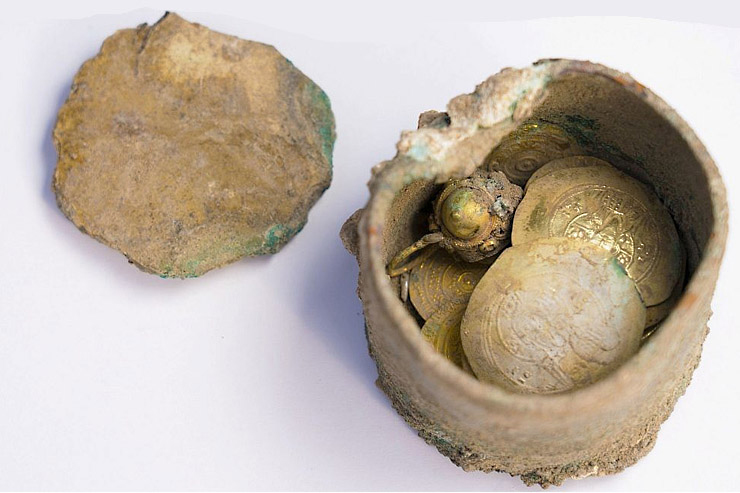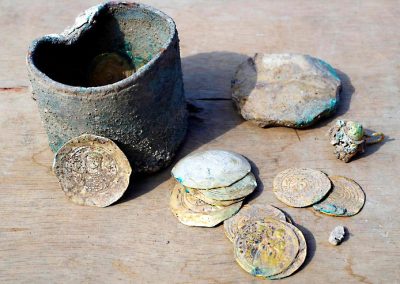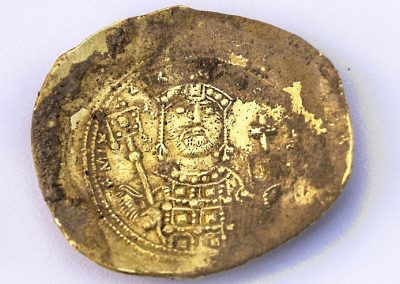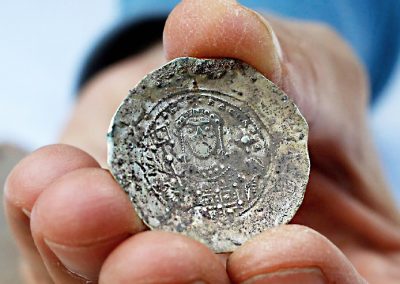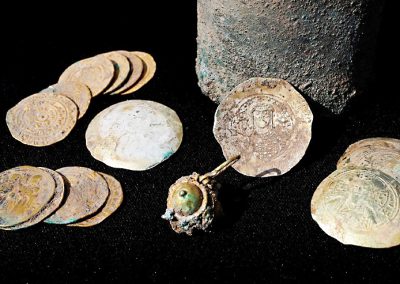
Bible, History, Archaeology
Bible,
History,
Archaeology
Gold coins discovered in Caesarea
Contents:
The discovery – The story – A solidus by Michel VII Doukas – Image gallery
The discovery
A rare treasure of 24 gold coins and an earring has been unearthed in the ancient port of Caesarea in northern Israel, probably buried by its owner to save it from the Crusader conquest of the city 900 years ago. © AFP.
The story
Caesarea, on the shores of the Mediterranean, was built in the second half of the 1st century B.C. by the Judean king Herod I. Significant remains from Roman and medieval times make Caesarea one of Israel's most attractive cities. Significant remains from Roman and medieval times make Caesarea one of Israel's top attractions.
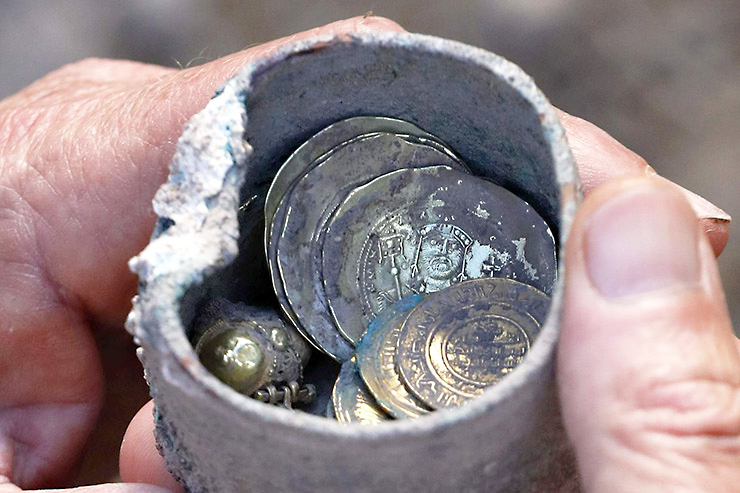
Image opposite: The pot of gold coins and an earring discovered during archaeological excavations in Caesarea. Caesarea Development Corporation.
In December 2018, the Israel Antiquities Authority and other organizations involved in this research announced that archaeological excavations had uncovered a small bronze pot, containing 24 gold coins and an earring. The pot was hidden between two stones near the well of a very old house.
Image opposite: The pot of gold coins and an earring discovered during archaeological excavations in Caesarea. Caesarea Development Corporation.
According to an analysis of the gold coins, presented to the press by Peter Gendelman and Mohammed Hatar, they date from the late 11th century and link the treasure to the Crusaders' conquest of the city in 1101. That year represents one of the most dramatic episodes in the city's medieval history.
According to historical sources, most of Caesarea's inhabitants were massacred by the army of Baldwin I, then King of Jerusalem. It is likely that the owner of the treasure and his family perished in the massacre, or were sold into slavery, never to recover their property.
According to Robert Kool, numismatic expert for the Israel Antiquities Authority (IAA), the treasure contains rare coins linked to the reign of Byzantine emperor Michael VII. These coins did not circulate only locally, and suggest contacts or possible trade relations between Caesarea and Constantinople (Byzantium) at that time.
One or two of these gold coins were equivalent to a farmer's annual salary, so it's likely that the person who hid the treasure came from a wealthy background or was a tradesman.
Solidus depicting Michael VII Doukas (1071-1079) in Constantinople, with the port of Caesarea in the background.
From left to right :
Reverse: Bust of Michael VII facing, bearded, crowned, wearing the loros, holding the labarum bouleté in his right hand and a cruciger globe in his left. Reverse translation: Michael the King.
Obverse: full-length bust of Christ, head crowned with cruciger nimbus, wearing pallium and colombium, blessing with right hand and holding Gospels with left hand. Obverse translation: Jesus Christ. © cbg.
An earring (detail) discovered during an archaeological dig in Caesarea. Caesarea Development Corporation.
An earring (detail) discovered during an archaeological dig in Caesarea.
An earring discovered during an archaeological dig in Caesarea. Caesarea Development Corporation.
An earring discovered during an archaeological dig in Caesarea.
A pot of gold coins and an earring discovered during an archaeological dig in Caesarea. Caesarea Development Corporation.
A pot of gold coins and an earring discovered during an archaeological dig in Caesarea.
Preliminary identification of coins discovered during archaeological excavations at Caesarea, by numismatic expert Rpbert Kool and excavation co-director Peter Gendelman. Yaniv Berman/Caesarea Development Corporation.
Identification of the coins discovered at Caesarea, by numismatic expert Rpbert Kool and excavation co-director Peter Gendelman.
A convex gold coin bearing the effigy of the Byzantine emperor Michael VII Doukas (1071-1079) discovered during archaeological excavations in Caesarea. Caesarea Development Corporation.
A convex gold coin bearing the effigy of the Byzantine emperor Michael VII Doukas (1071-1079) discovered during archaeological excavations in Caesarea.
Another coin with the seal of Byzantine emperor Michael VII Doukas (1071-079) discovered during archaeological excavations in Caesarea. Caesarea Development Corporation.
Another coin bearing the seal of the Byzantine emperor Michael VII Doukas (1071-079), discovered during archaeological excavations in Caesarea.
In 2015, 2,000 1,000-year-old gold coins were recovered by divers, the largest numismatic treasure unearthed in Israel. Israel Antiquities Authority.
In 2015, 2,000 1,000-year-old gold coins were recovered by divers, the largest numismatic treasure unearthed in Israel.

